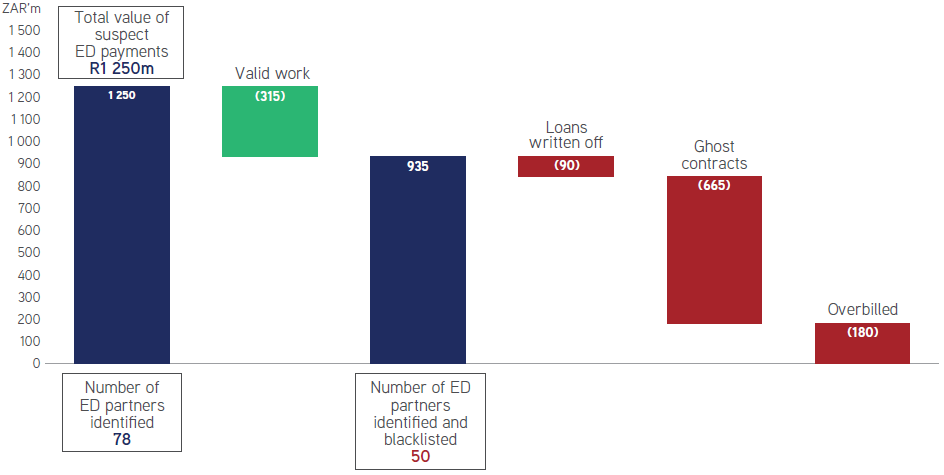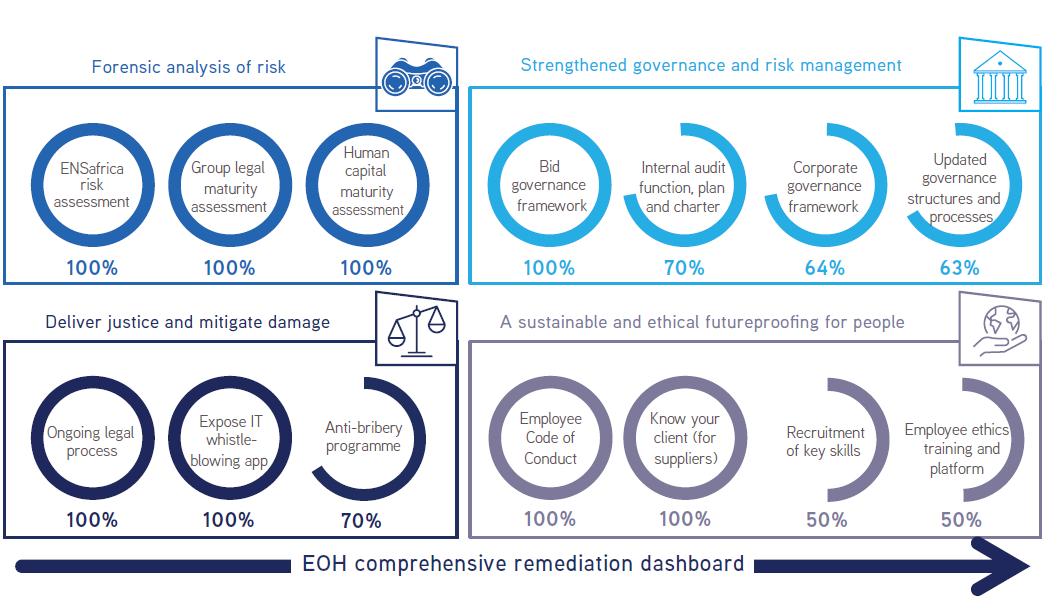2019
Integrated report

Currently viewing: Comprehensive Remediation Plan Status Report / Next: Risk Overview
EOH has taken ambitious and extensive action to understand, learn and take remedial action to futureproof itself against corruption, and to ensure fresh, sustainable frameworks that will enable oversight and decision making that drives value creation.
Following the identification of corruption EOH mobilised a comprehensive remediation plan. This plan entailed a forensic analysis of the situation, supported by a robust legal process to ensure justice and restitution. The plan also included the implementation of a refreshed governance, risk management and compliance framework to ensure future best practice across the business. The purpose of the remediation plan has been to address wrongdoing, to ensure futureproof best practice, and to ensure a sustainability agenda that will enhance value for all our stakeholders. This section of the report will transparently outline our status on delivery of the comprehensive remediation plan.
Our first step was to forensically analyse our existing position to understand the scope of wrongdoing, the state functional capabilities were in, and to understand the skills and talent that were in place. This review of functional capabilities discovered critical weaknesses in governance, risk and control management, as well as legal, internal audit, procurement, supply chain and human capital processes. This process also enabled the consolidation of a fresh overview of EOH risk. Independent and internal capability assessments were then translated into the action plans for the improvement of governance, the fair pursuit of justice, as well as an agenda to support enhanced sustainability. Great attention was paid to the recruitment of new skills.

Purpose: To ensure full understanding of the extent of wrongdoing and to assess all EOH operations for risk. Further to this, assessing the maturity of EOH capabilities and human capital required to manage legal, compliance, and governance responsibilities in the futureproof state.
Status: Complete

Purpose: Mobilise a best practice corporate governance, risk management and audit framework and capability to futureproof against corruption and bribery, ensuring compliance, the mitigation of risk and best practice decision making to create value for all EOH stakeholders.
Status: In progress

Purpose: To manage the EOH legal process relating to corruption identified and to ensure justice and the remediation and restitution for impacted stakeholders. To create safe and accessible channels for the future reporting of wrongdoing via an effective anti-bribery programme committed to the good.
Status: In progress

Purpose: To recruit the skills and professional capabilities needed for the future, while training staff, suppliers and partners on an updated employee Code of Conduct and new bid processes. To deliver enterprise-wide training in ethics and updated governance practices, supported by a new learning platform.
Status: In progress
As we end the 2019 financial year the legal process is ongoing. EOH has committed to tenaciously pursuing diligent, fair and proper remediation and restitution. Of the 16 implicated EOH employees, 11 have resigned or been dismissed, with eight reported to the Financial Intelligence Centre ('FIC'). The chart below indicates the status on the process for enterprise development directors and partners, as well as government employees. In total 78 enterprise development partners were picked up by the process, along with R1 250 million of suspect payments. While there were loans that were suspiciously written off or outstanding, the majority of suspicious payments (to a value of R665 million), were ghost contracts within the EOH Mthombo business. EOH is committed to following the legal process, and with a focus on ensuring the restitution of value to impacted stakeholders.


Material progress has been on achieving strengthened governance and risk management. The bid governance framework has been rolled out and is being embedded. Additionally an internal audit function has been mobilised with a plan and charter to ensure improved oversight. The Board has approved a new best practice corporate governance framework that is in the process of being implemented, along with updated governance structures and processes.
There has been extensive action to recruit employees to fill skill gaps that were identified by capability assessments. In addition to the new employee Code of Conduct there has been extensive action to mobilise training for both staff and suppliers. The newly mobilised CODE programme has been put in place to shift the organisation toward an approach that integrates an ethical corporate philosophy across the EOH Group, to create a focus on shared value creation.
Over the last year EOH has learned many hard lessons. A sustainable future depends upon our ability to assimilate this learning and to take tangible action to change. This is a significant undertaking given the scale of the business. EOH leadership understands the critical role that it needs to play in order to ensure that new frameworks are adopted and that the profound opportunity we have to accelerate toward a better future is realised for all our stakeholders.